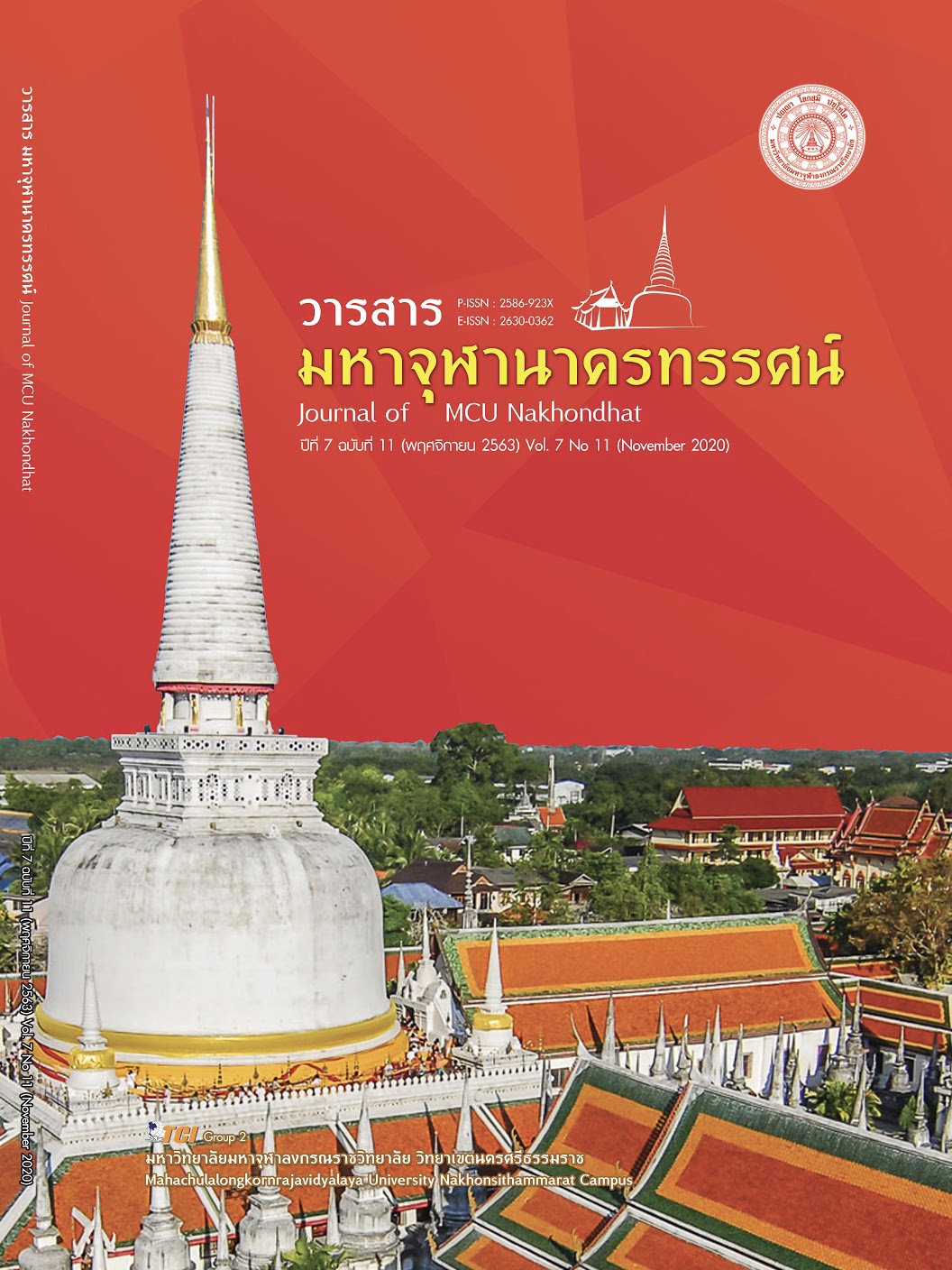BUDDHIST COMMERCIALIZATION IN BUDDHIST INSTITUTIONS
Main Article Content
Abstract
From the global trend, under the main parent system,thinking of producing for the benefit and the benefit of using money as medium.In the middle of the exchange of words,thoughts,beliefs,beliefs in religions that have been exchanged through the Buddhist code of commerce,there are methods for creating and writing.What to those who have faith and faith in the Phutthaphanich’s services,which is effective will bring a lot of income.But the introduction of Buddhist beliefs and transformed them into products on the basis of miracles,
Creating a just way for the attainment of the understanding of Phuttaphanich, starting with the amulet that in Thai society in the origin of the amulet has been developed from the Buddha Dharma,the amulet or the Dharma in this era.Excellent in the “Phutthakhun”,the later era is looking at the amulet in the sense of “Buddhism” such as the belief in the supernatural.Came to warn the morale of fighting during the war.Later,the era of popular amulets is the subject of “Buddhism Arts”.Popularity around the end of the 4th,held that the amulet was the most ousstanding in the Phutthaphanich arts, as evidenced by its popularity and collection.Accumulated as a personal treasure in the era at present,the most obvious is Buddhism is a method of creating games and a need for the form of goods and services.Buddhist traditions are the base of religious beliefs.It’s hard to make that impact.Understanding the Phutthaphanding and approaches to quenching puzzles according to the teachings of not before present benefits and the best interests of Buddhism.
Article Details
References
ณัฐพล อยู่รุ่งเรืองศักดิ์. (2555). ประวัติศาสตร์ผ่านพระเครื่อง: คติความเชื่อและพุทธพาณิชย์. นครปฐม: โรงพิมพ์มหาวิทยาลัยศิลปากร.
บุศรา สว่างศรี. (2549). พุทธพาณิชย์: พระเครื่อง. ใน วิทยานิพนธ์ศิลปศาสตรมหาบัณฑิต สาขาสื่อสารมวลชน. มหาวิทยาลัยศิลปากร.
ปรีชา ช้างขวัญยืน และสมภาร พรมทา. (2552). มนุษย์กับศาสนา. (พิมพ์ครั้งที่ 4). กรุงเทพมหานคร: โรงพิม์แห่งจุฬาลงกรณ์มหาวิทยาลัย.
พระครูสังฆรักษ์ศุภณัฐ ภูริวฑฺฒโน และศิลาวัฒน์ ชัยวงศ์. (2559). มอดศาสนา ภัยคุกคามที่พระสงฆ์อาเซียนต้องระวัง. วารสารพุทธอาเซียนศึกษา, 1(2), 7-8.
พระราชวรมุนี (ประยุทธ์ ปยุตฺโต). (2538). พจนาพุทธศาสตร์ ฉบับประมวลธรรม. (พิมพ์ครั้งที่ 8). กรุงเทพมหานคร: โรงพิมพ์มหาจุฬาลงกรณราชวิทยาลัย.
ภณกุล ภวคุณวรกิตติ์. (2555). พุทธพาณิชย์และไสยพาณิชย์ในพุทธศาสนาเชิงปฏิบัติของไทย: กรณีศึกษาวัดในจังหวัดนครปฐม. ใน วิทยานิพนธ์ศิลปศาสตรมหาบัณฑิต สาขาพัฒนามนุษย์และสังคม. จุฬาลงกรณ์มหาวิทยาลัย.
ราชบัณฑิตยสถาน. (2525). พจนานุกรมฉบับราชบัณฑิตยสถาน พ.ศ. 2525. กรุงเทพมหานคร: สำนักพิมพ์อักษรเจริญทัศน์.
วัชระ งามจิตรเจริญ. (2552). แนวคิดในการใช้พุทธธรรมเพื่อดำเนินการทางเศรษฐกิจในสังคมทุนนิยม: กรณีศึกษา. กรุงเทพมหานคร: โรงพิมพ์แห่งจุฬาลงกรณ์มหาวิทยาลัย.
วีรยุทธ เกิดในมงคล. (2560). รูปแบบและวิธีการทางธุรกิจกับพุทธพาณิชย์ในสถาบันพระพุทธศาสนา. วารสารพุทธศาสน์ศึกษา จุฬาลงกรณ์มหาวิทยาลัย, 24(1), 62-67.
ศรีศักร วัลลิโภคม. (2527). การถือผีในเมืองไทย. วารสารศิลปวัฒนธรรม, 5(4), 6-17.
ศรีศักร วัลลิโภคม. (2527). พระเครื่องในเมืองสยาม. (พิมพ์ครั้งที่ 2). กรุงเทพมหานคร: สำนักพิมพ์มติชน.
สงคราม สุเทพากุล. (2556). พุทธพาณิชย์. ใน วิทยานิพนธ์ศิลปศาสตรมหาบัณฑิต สาขาทัศนศิลปศึกษา. มหาวิทยาลัยศิลปากร.
สราญมิตร์ ประชาญสิทธิ์. (2547). โลกศักดิ์สิทธิ์ (The sacred) และโลกสามัญ (The profane) นัยความหมายของทุนวัฒนธรรมการท่องเที่ยวต่อระบบเศรฐกิจและการจัดการ. ใน ดิเรก ปัทมสิริวัฒน์ และพัชรินทร์ สิรสุนทร (บรรณาธิการ). ทุนสังคม และทุนวัฒนธรรมในระบบเศรฐกิจและการจัดการยุคใหม่ (หน้า 87 - 134). กรุงเทพมหานคร: โรงพิมพ์ พี.เอ.ลีฟวิ่ง จำกัด.


